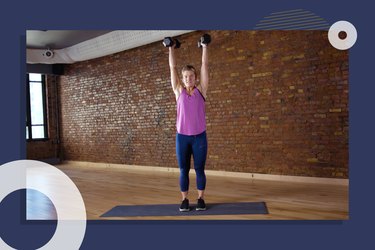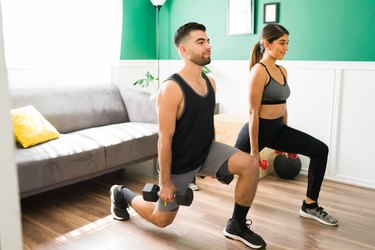
Workout methods with numbers in the name have really been having a moment lately. The 12-3-30 treadmill workout, the 3-2-8 Pilates workout, the 3-2-1 fitness method — the list goes on. There's a good reason for the trend, though: They're easy to follow along with because they lay out exactly what you'll be doing.
Another one seeing an increase in popularity these days? The 6-12-25 workout. We asked two personal trainers to weigh in on whether it's worth the hype.
Video of the Day
Video of the Day
What Is the 6-12-25 Workout Method?
Created by the late Canadian strength coach Charles Poliquin, the 6-12-25 workout is a "structured training protocol that targets one muscle group per set using three different exercises with minimal rest between them," says personal trainer Or Artzi, CPT, a lead group fitness instructor at Equinox and creator of the fitness platform Orriors.
It's all about maxing out your muscle fibers with three different rep ranges done back-to-back to build muscle mass and strength, according to certified strength and conditioning specialist Noam Tamir, CSCS, founder and CEO of TS Fitness.
Here's a quick breakdown:
- 6 reps of a heavy compound exercise: This is the most demanding exercise of the workout where you'll lift the most weight.
- 12 reps of a less demanding exercise: You'll lift a slightly lighter weight than you did with the 6 reps above.
- 25 reps of the least complex exercise: You'll focus more on endurance and muscle fatigue. You'll use a light weight that you can do 25 reps with.
- Rest: If you want to do more than one round, take a 90- to 120-second break before diving back in.
While on the surface, the numbers 6, 12 and 25 might seem totally random, there's a legitimate reason behind the programming. "These numbers are strategically chosen to target both fast-twitch and slow-twitch muscle fibers in the most effective way," Tamir says. (Fast-twitch muscle fibers are responsible for creating short, powerful muscle contractions, while slow-twitch muscle fibers create slow contractions for max endurance.)
The 6 reps focus on raw strength and power, the 12 reps maximize hypertrophy and volume and the 25 reps push endurance and increase blood flow, "creating the perfect combination for muscle growth and performance," Tamir says.
How to choose the correct amount of weight for your reps
Weight selection is key for being able to effectively use the 6-12-25 workout method, according to Artzi. In order to know how much weight you can lift, use the reps-in-reserve rule:
- If you reach 6 reps and still have 3 to 4 reps left in the tank, increase weight the next time around.
- If you finish 12 reps feeling like you could have done 15 or more, increase weight the next time around.
- If you finish 25 reps feeling like you could have done more, increase weight the next time around.
The Benefits of the 6-12-25 Workout Method
There are numerous reasons to opt for the 6-12-25 workout method during your next strength session:
- It's great for building muscle strength, size and endurance. This is because this method hits all your muscle fibers, targeting both fast-twitch and slow-twitch, due to the wide rep range, according to Tamir.
- It's time-efficient. "If you're short on time, this workout delivers maximum results in minimal time," Tamir says.
- It keeps your workouts engaging. "The variety of rep schemes can make training more interesting and prevent plateaus," Artzi says.
- It optimizes your workout volume and intensity. You get a balanced mix of heavy lifting (aka, intensity) and total work done (aka, volume), according to Artzi.
Are There Any Drawbacks to the 6-12-25 Workout Method?
While this is an effective workout, there are a few things to consider before giving it a try:
- It's not beginner-friendly. "The intensity and endurance required may be too advanced for new lifters," Artzi says.
- It's taxing on your muscles. "Overstressing the muscles can lead to overtraining and stalled progress," Tamir says. "To make this method truly effective, adequate recovery is key because your muscles need time to rebuild and grow."
- It may be easy to get injured. It's essential to choose movements that work well across all three rep ranges to avoid early fatigue or poor mechanics, per Tamir. "As fatigue sets in, especially during the high rep ranges, maintaining good form is crucial to avoiding injury," he says.
3 Workouts You Can Do Using the 6-12-25 Method
Ahead, Artzi created three sample workouts you can do with the 6-12-25 method. One targets your chest and arms, one targets your back and arms and one targets your lower body. Slot these into your strength sessions on days you're focusing on those specific muscles.
1. Chest and Arms Workout
1. Dumbbell Chest Press (6 reps)
- Grab two heavy dumbbells and lie flat on a bench or the floor.
- Start in a prone (overhand) grip with your palms facing away from you toward your feet.
- Exhale as you press the dumbbells upward and inward until your arms are almost fully extended and the dumbbells nearly touch.
- Inhale as you slowly bend your elbows again, lowering your arms gently back to the starting position.
- Perform 6 reps.
2. Cable Chest Fly (12 reps)
- Set the pulleys on a dual-cable machine to chest height, and stand between the two stacks. Set the weight on the cable machine to something moderately heavy.
- Grab the handles with your palms facing forward and raise your arms out to the sides.
- Take a few steps forward to create tension on the cables, making sure your elbows still have a slight bend in them.
- Stagger your feet so that one foot is in front of the other.
- Brace your core, then pull your hands in toward each other in front of you, pausing when your hands touch.
- Return to the starting position.
- Perform 12 reps.
3. Cable Triceps Pushdown (25 reps)
- Attach a rope handle to the high pulley of a cable machine. Set the weight on the cable machine to something light.
- Grab each side of the rope handle with each hand, palms facing down.
- Tuck your elbows into your sides, brace your core, and straighten your elbows by moving your palms toward the floor, keeping your upper arms stable.
- After your elbows are fully extended, bend them again to 90 degrees, returning to the starting position.
- Perform 25 reps.
2. Back and Arms Workout
1. Pull-Up (6 reps)
- Hang from a bar with an overhand grip, hands shoulder-width apart or a little wider.
- Squeeze your core and lower-body muscles, pull your shoulder blades down and together, then bend your elbows to pull your chin toward the bar.
- Keep pulling until your chin is above the bar.
- Pause for a moment, keeping your shoulders down and away from your ears.
- Reverse the movement by lowering your body, with control, to return to the starting position.
- Perform 6 reps.
2. Straight-Arm Lat Pulldown (12 reps)
- Attach a short straight bar to a cable pulley high above your head. Set the weight to something moderately heavy.
- Hold each end of the bar and take a few steps back.
- Bend your knees slightly and hold the bar with straight arms, palms facing down.
- Keeping your elbows straight and back flat, draw the bar down until it's in line with your hips.
- Slowly reverse the motion, keeping your arms straight.
- Perform 12 reps.
3. Cable Straight-Bar Biceps Curl (25 reps)
- Attaching a straight bar to a low cable pulley. Set the weight to something light.
- Grab the bar with an underhand grip (palms facing up) with your hands shoulder-width apart.
- With your arms straight, take a step back from the pulley so there's tension in the cable.
- Bend your elbows to lift your hands toward your shoulders. Keep your elbows tucked into your sides the entire time.
- Extend your elbows back to the starting position.
- Perform 25 reps.
3. Lower-Body Workout
1. Deadlift (6 reps)
- Add heavy weight plates to a barbell and position it on the floor in front of you. If needed, position it on an elevated platform to allow for a reduced range of motion.
- Step up to the bar, shins almost against it, feet planted firmly hip-width apart. Keep your spine straight, chest up and shoulders back and down.
- Hinge from the hips, softening your knees as your hips sink low enough to let you grasp the bar with your hands shoulder-width apart. Your spine should be straight and long, chest up and open, shoulders back.
- Engage all the muscles of your core to maintain this position as you press your feet into the floor, as if you were trying to push the floor away from you, and lift the bar.
- Finish the motion by lifting your chest and engaging your lats to stabilize the bar in front of your hips.
- Return the bar to the ground by reversing the motion, pushing your weight back into your hips and softening your knees, letting the bar travel in a controlled path back down to the floor along your body.
- Perform 6 reps.
2. Bulgarian Split Squat (12 reps)
- Stand a few feet in front of a bench, box or chair, facing away from it.
- Reach your left foot back and place the top of your foot flat on the surface. To help with balance, widen your base of support by moving your left foot a few inches to the left.
- Lean your torso forward slightly and bend your front knee to sink your hips toward the floor as low as you can comfortably go.
- Your front-leg shin should be vertical or close to it, while your back knee should point down toward the floor. If either leg is out of place, move your front foot forward or backward until you've found the ideal positioning.
- Push through the middle of your front foot to return to standing.
- Perform 12 reps on each leg.
3. Dumbbell Hamstring Curl (25 reps)
- Place a light dumbbell on the floor, standing on one end.
- Lie down on the floor on your stomach, legs straight and one foot on either side of the dumbbell.
- Squeeze the weight between the inner parts of your feet and bend your knees to lift it just off the floor.
- Extend your legs back down to the starting position.
- Perform 25 reps.


